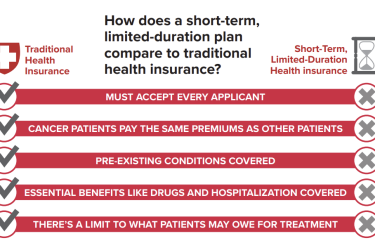
Every day, some 10,000 Americans become eligible for Medicare, a rate that’s projected to continue for the next 18 years, as the Federal Reserve Bank of St. Louis estimated in 2019.
For health care journalists, these startling numbers mean we have an important role to advise seniors on the best plans to meet their needs during Medicare’s annual open enrollment (Oct. 15 through Dec. 7). Our advisory role seems to become more important every year as costs rise and because we need to counteract the messages seniors get in the annoyingly frequent advertisements for Medicare Advantage (MA) plans.
Medicare open enrollment
During Medicare’s open enrollment period, seniors face a dizzying array of choices about whether to choose traditional Medicare or a MA plan or if they should add a Medicare Part D prescription drug plan.
So much advertising and reporting are devoted to MA and Part D plans that the more comprehensive coverage available to seniors through Medicare Supplement plans (also called Medigap) gets all but drowned out.
In a new tip sheet, health care journalist and former AHCJ president Trudy Lieberman (@Trudy_Lieberman) explains why reporters covering health care for seniors should write about the benefits of Medigap plans.
“People are being lured into Medicare Advantage plans with a false sense of security by the promise of no premium or a low premium,” she said. “Medicare Advantage plans may leave gaps in coverage, and they come with large upfront, out-of-pocket costs. Also, MA plans usually have restrictive networks of hospitals and doctors.”
A resident of New York City, Lieberman pays $270 a month for her Medigap Plan G. “If you buy the right Medicare supplement plan, that plan will cover you for just about everything,” she commented. “None of us knows when a costly illness will strike.”
In 2017, Lieberman was diagnosed with a common urinary tract infection and the medicine she was prescribed caused a serious side effect: aplastic anemia. The condition led to pneumonia and other problems, requiring a four-month hospital stay.
“The total cost of my care was way north of $1 million, and because I had good retiree coverage from my employer at the time, everything was covered except about $2,000, which we paid,” she said. “Without that coverage, we would have really been in trouble, and the illness was all unexpected.”
Last year, her former employer dropped retiree coverage, and she bought Medigap Plan G. “Before that infection, I was perfectly healthy,” she added. “When they’re healthy, most people think they’ll remain that way. But people cannot judge their own health risks very well.”
Why Americans are drawn to MA plans
As Lieberman suggested, most Americans are drawn to MA plans when they enroll either three months before turning 65 or three months later. Therefore, they may not even consider a Medigap plan that could provide comprehensive coverage for a lifetime. Projections from the federal Centers for Medicare and Medicaid Services (CMS) show that 29.5 million people will enroll in MA plans for coverage starting Jan. 1, an increase of almost 10% over the current enrollment of 26.9 million. During this time, seniors eligible for Medicare should consider staying in original (also called traditional or fee-for-service) Medicare and get a Medigap plan and a Medicare Part D prescription drug plan.
A need for better Medicare coverage
The story about the value of Medigap plans, especially when they are compared to MA plans is vitally important for Medicare members and journalists. In response to a health care column, she writes for community newspapers nationwide, Lieberman gets more questions about Medicare than any other topic. She also writes for the Center for Health Journalism, and two years ago, explained that journalists used to cover Medicare closely but have not done so in recent years. That article is, “Health care reporters used to be Medicare hounds. What happened?”
The truth is that MA and their companion Part D plans are designed so health insurers selling them can make money. Early this month, the Kaiser Family Foundation reported that the average Medicare beneficiary has access to 39 MA plans for 2022, the most available in more than a decade. For 2022, health insurers are offering a record 3,834 MA plans nationwide, an 8% increase over the number of plans available this year, the foundation noted. In that same report, the organization showed that MA enrollment is concentrated in health plans from UnitedHealthcare and Humana (which together have 45% of the MA market nationwide) and from Blue Cross Blue Shield affiliates.
Problems with MA plans
What too often goes unreported, however, is that there at least three problems with MA plans. First, MA plans can lead to high deductible and copayment costs for seniors who develop chronic conditions such as cancer, diabetes, high blood pressure, high cholesterol or heart disease. Second, once enrolled in an MA plan, changing to a more comprehensive Medigap plan can be costly in all but four states (Connecticut, Maine, Massachusetts and New York). In the other 46 states, health insurers can review the medical history of an enrollee in MA or traditional Medicare and then those insurers are likely to charge much more for a new policy or decline to offer Medicare members a Medigap plan.
Third, enrollment in Medigap is allowed only during a senior’s initial enrollment in Medicare, when turning 65, or if the senior has a qualifying event, such as a loss of retiree health coverage. Most seniors are relatively healthy at age 65, but no one can predict what conditions will develop over time. In the other 46 states and the District of Columbia, insurers may deny a Medigap policy to seniors with pre-existing health conditions, the Kaiser Family Foundation said in a 2018 report.
The tip sheet covers these topics in more depth and highlights other issues of interest to journalists and Medicare members.









